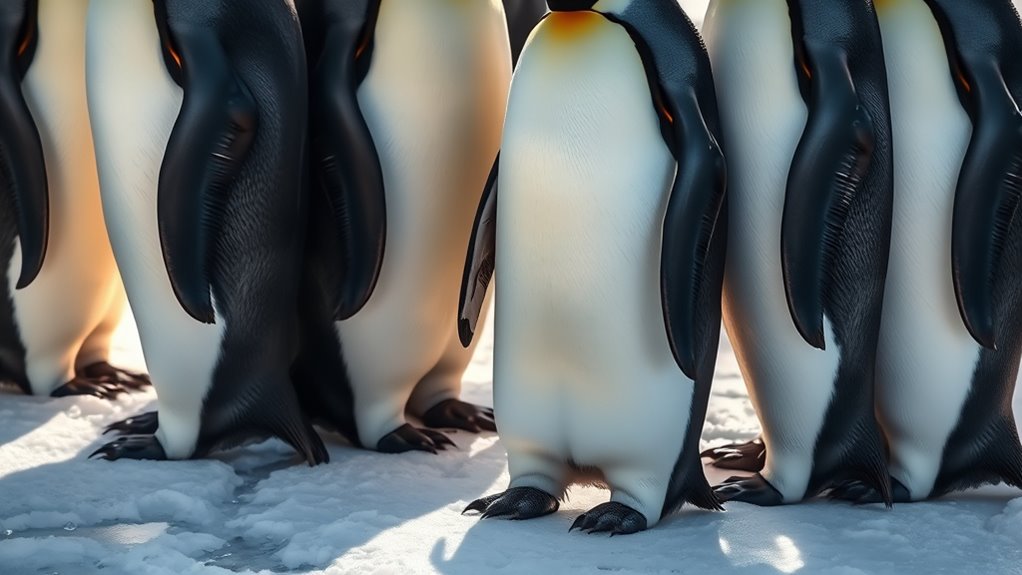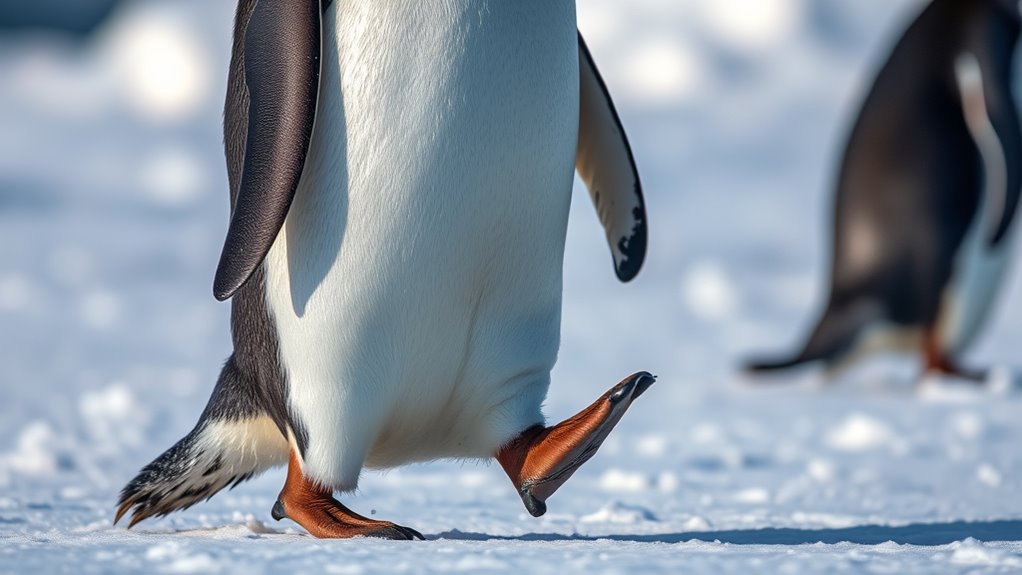Yes, penguins do have knees! However, you can’t see them because they’re tucked away under feathers. Their unique knee structure helps with stability and control while swimming, aiding in their impressive movements underwater. Even on land, those hidden knees support waddling and social interactions, especially during courtship rituals. If you’re curious about how these concealed knees contribute to their swimming efficiency and social behaviors, there’s more fascinating information waiting for you!
Key Takeaways
- Penguins do have knees, but they are hidden beneath their feathers and not externally visible.
- The knee joint in penguins is crucial for stability and control while swimming.
- Their unique skeletal structure, including hidden knees, contributes to their streamlined body for efficient movement.
- Penguins use their knees to assist in waddling and maintaining balance during social interactions and courtship displays.
- The adaptation of concealed knees allows penguins to thrive in aquatic environments while engaging in essential social behaviors.

Have you ever wondered if penguins have knees? You might be surprised to learn that, yes, they do have knees, but they’re not quite like ours. Penguins have a unique skeletal structure that includes a knee joint hidden beneath their feathers. This anatomical feature helps them maintain their sleek, streamlined shape, which is essential for efficient penguin swimming. When you observe them diving into the icy waters, their bodies glide effortlessly, showcasing the power of their hidden joints.
While watching penguins swim, you can’t help but marvel at how gracefully they move through the water. Their wings, which are adapted into flippers, allow them to propel themselves with incredible speed. The way they’ve evolved for swimming is fascinating; their knees play a crucial role in their mobility. Although they can’t bend their legs like we do, their knees help them maintain stability and control while they swim. Imagine a penguin diving under the waves, using its powerful legs and flippers to navigate the frigid ocean depths, all while that little knee joint is working behind the scenes.
Penguins glide gracefully through water, their hidden knees essential for stability and control in their swift underwater journeys.
When it comes to penguin mating behaviors, things get even more interesting. Penguins are known for their strong pair bonds, often engaging in elaborate courtship rituals. You might see them bowing, vocalizing, and even presenting pebbles to each other as a token of affection. These behaviors are essential for establishing connections, and surprisingly, their physical structure, including their knees, plays a role in these interactions. During mating season, you’ll notice how they waddle and move about, their knees helping to balance and support them as they perform their fascinating displays.
As you watch these captivating creatures, you’ll appreciate how their unique anatomy contributes to both their swimming prowess and social behaviors. Penguins are truly remarkable animals, adapting to their harsh environments while maintaining strong family bonds. So, the next time you see a penguin slipping gracefully into the water or engaging in playful courtship, remember that there’s more to these enchanting birds than meets the eye. Their knees, although cleverly disguised, play a vital role in their everyday lives, from swimming to socializing, revealing the wonders of nature and evolution.
Frequently Asked Questions
Can Penguins Fly Like Other Birds?
No, penguins can’t fly like other birds. Their wing structure has evolved for swimming rather than flying, making them excellent divers instead. You’ll notice their wings are more like flippers, allowing them to propel through water with agility. While other birds soar through the skies, you’ll find penguins gliding gracefully underwater, showcasing their unique penguin flight capabilities. So, while they might not take to the skies, they certainly navigate the seas with skill.
What Do Penguins Eat in the Wild?
Imagine diving into a vast ocean, where each wave carries the secret of a penguin’s diet. In the wild, these remarkable birds feast primarily on fish, squids, and krill, showcasing their wild feeding habits. Their diet symbolizes survival in harsh climates, as they navigate icy waters in search of sustenance. Penguins rely on their agility and teamwork, diving deep to catch their meals, ensuring they thrive in their challenging environment.
How Do Penguins Stay Warm in Cold Climates?
Penguins stay warm in cold climates by using their thick layer of blubber and dense feathers that trap heat. During their breeding season, you’ll notice they huddle together to conserve warmth, especially when mating. Their breeding habits also include forming strong bonds that help them keep close during harsh weather. So, when you see them cuddling, they’re not just being cute; they’re making sure they survive the frigid temperatures together.
Where Do Penguins Live Around the World?
Penguins primarily live in the Southern Hemisphere, especially in Antarctica, but also in parts of South America, Africa, Australia, and New Zealand. You’ll find them in various habitats, from icy shores to temperate regions. Their migration patterns often lead them to breed in colonies during specific seasons, showcasing unique breeding behaviors. These patterns guarantee they stay safe and productive, adapting to their environment while raising their young in large groups.
Are Penguins Social Animals or Solitary?
Penguins are incredibly social animals, thriving in large colonies. You’ll find them huddling together for warmth and protection. Their communication is fascinating; they use a range of vocalizations and body language to express themselves. During mating habits, they often engage in elaborate courtship displays, strengthening their bonds. These social interactions not only guarantee successful breeding but also create a tight-knit community, showcasing the importance of companionship in their lives.
Conclusion
So, while you might picture penguins waddling without a care, they’re actually sporting knees hidden beneath their feathers. Imagine the contrast: a creature that seems so clumsy on land has a complex skeletal structure enabling agile swimming. Those knees, though tucked away, are vital for their movement and survival. Next time you see a penguin, remember the hidden mechanics that power their quirky charm, blending elegance in the water with a delightful awkwardness on the ice.










